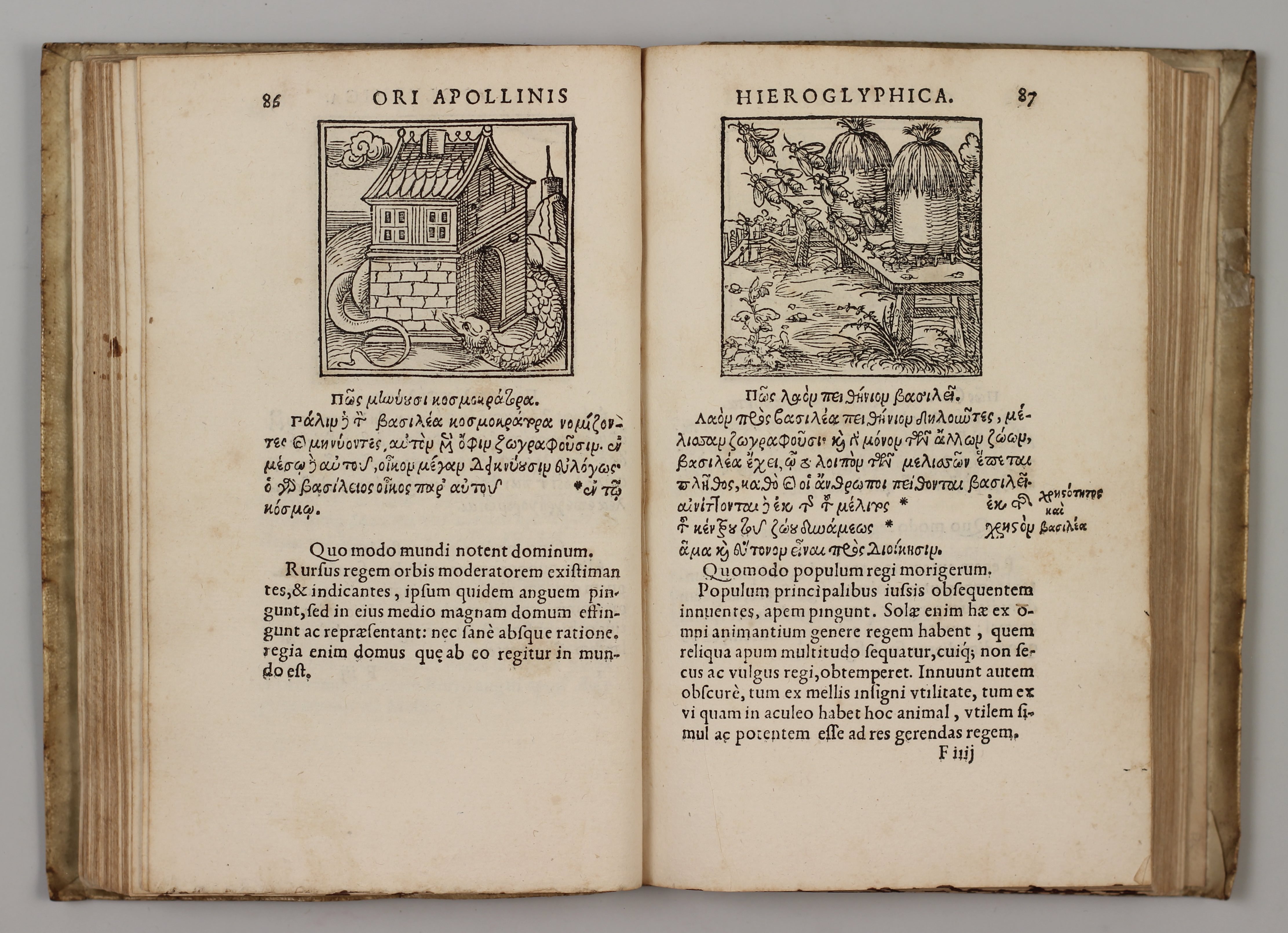Horapollo
Hieroglyphica in Greek — Paris 1551
3.400 €Ὤρου Ἀπόλλωνος Νειλώου ἱερογλυφικά. Oris Apollinis Niliaci, De sacris notis & sculturis duo, ub ad fidem vetusti codicis manu scripti restituta sunt loca permulta, corrupta antehac deplorata. Quibus acceßit versio recens, per Io. Mercerum [Jean Mercier] uticensem concinnata, & observationes non infrugiferae. — Parisiis, Apud Iacobum Kerver …, 1551
[Colophon:] Excudebat G. Morelius Iacobo Keruer, Lutetiae Parisiorum, M.D.LI.
[Paris, Morel for Kerver, 1551].
8vo (165 x 108 mm). A8 B2 A-P8 O2 : (10) leaves, 240 pp., (2) leaves. Woodcut on F7 recto upside-down and woodcut on G7 verso on pasted slip, both as in Mortimer. Editor’s name, Jean Mercier, scored through on title; slighlty spotted. Bookplate on paste-down. Manuscript title to bottom edge. Contemporary limp vellum.
Mortimer 315; CTC VI 26ff.; Adams H 850; Hoffmann II2 384.
„… the first real commentary on Horapollo’s text did not appear until 1548, when the Hebrew scholar Jean Mercier published his Latin translation with Observationes. Mercier prepared a second edition of his translation and commentary in 1551 after he had studied the Greek manuscripts in more detail. This improved translation appears with all subsequent editions that include Horapollo in Latin …“ It is the Codex Morellianus, i. e. that of the printer Guilleaume Morel, that let Mercier improve his translation. „Mercier appended the text of seven extra hieroglyphs, which he may have written himself, to his 1551 edition. Half of them contain Christian symbols, demonstrating that a close relationship between Egyptian mysticism and Christian revelation was taken for granted by Renaissance scholars … Although Horapollo’s work can contribute little to modern Egyptology, it obviously is of great historical interest to those who seek a thorough, unbiased knowledge of Renaissance literature and art. The Hieroglyphica was taught to schoolchildren, discussed in scholarly colloquia, and consulted by artists throughout Europe.“ (CTC VI 16ff.).
On the neoplatonic background of the Renaissance interest in the Hieroglyphica see Boas‘ introduction to his translation quoting Plotinus on the Egyptian hieroglyphics: “ ‚Thus each picture was a kind of understanding and wisdom and substance and given all at once, and not discoursive reasoning and deliberation‘ … Two points were thus established: (1) that true knowledge was a contemplation of Platonic ideas in visual form; (2) that this had been made possible in Egyptian hieroglyphs.“1
Illustrations: „One hundred ninety-five woodcuts (including five repetitions), among them cuts attributed to Jean Cousin or Jean Goujon. This series first appeared in the French edition of 1543. In this, 1551, edition seven of the 1543 blocks have been replaced with new blocks slightly or entirely redesigned … The order of the blocks varies slightly, and several of the cuts printed at the end of the 1543 edition, as added by the translator, are distributed throughout the volume in this edition.“ (Mortimer).
„Hierolgyphs became fashionable [in the 16th c.], even omnipresent, and Horapollo, both alone and supplemented by Valeriano, remained for the next century and a half the most coharent and accessible – if also the most suspect – source for both the symbols and their meanings … Thirty editions, after the editio princeps of the Greek text in 1505, attest to its appeal. This austere and brittle little book, in other words, became the foundation on which ambitious works of poetry and philosophy, art and archticeture rested.“ (Anthony Grafton)2.
—————————
1 The Hieroglyphs of Horapollo. Translated and introduced by George Boas. With a new foreword by Anthony Grafton. Princeton, UP, 1993, pp. 8f. 2 p. xix.







